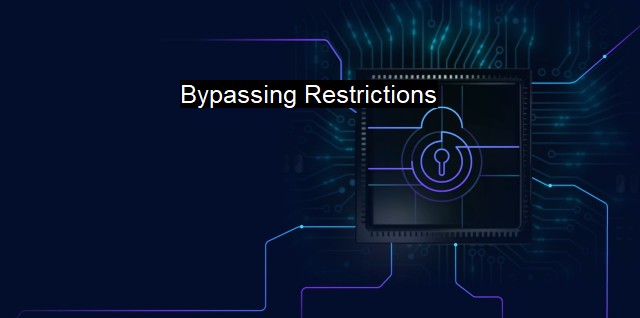What are Bypassing Restrictions?
Cybersecurity: Bypassing Restrictions and the Threats of Hacking - Methods and Techniques Used by Cybercriminals to Circumvent Barriers and Gain Unauthorized Access.
"Bypassing Restrictions" refers to the various methods and techniques hackers, malicious users, and some benign programs utilize to evade the digital fences put in places to block or restrict specific types of actions, behaviors, or access to certain resources in a computer system. These restrictions could be related to firewall configurations, security rules, website access, software installation, or antivirus scanners, among others.One key area where "Bypassing Restrictions" is prevalent is when hackers strive to circumvent security measures on network systems. These measures often include firewalls that have been designed to monitor incoming and outgoing network traffic based on set security rules. If understood thoroughly, malicious users can craft their cyber attacks in a way that interrupts security rules or splits the attack into smaller, unnoticeable pieces. Through this, they manage to trick the system, bypassing any restrictions, and gaining unauthorized access.
This bypassing has repeatedly proven to be a thorn in the flesh of many organizations' cybersecurity efforts. It not only exposes systems to potential attacks but also makes data protection a complicated task. The increase in incidences of malwares designed to evade detection from conventional antivirus software by masking their code has also driven better innovation and development of newer and advanced security solutions.
For instance, clever criminals camouflage malicious software in what appears to be a legitimate file (also known as obfuscation). This is a popular method of bypassing antivirus restrictions where a malicious code is changed to appear harmless to avoid detection by antivirus software. Such tactics pose significant challenges to antivirus vendors, who continuously advance their detection capabilities in response to evolving threats.
Rooting and jailbreaking of smartphones could also be classified as ways of bypassing restrictions. These practices involve modifying the device's operating system to gain greater access or control over the device. While this can enhance the functionality of the device, it also exposes devices to a wide range of security threats. This is because in performing such modifications, restrictions designed to protect the user and system integrity, possibly put up by the device manufacturer, are broken away.
There's also another technique called privilege escalation, which plays a crucial role in bypassing restrictions. In this method, a user or process gains unauthorized privileges or access rights within a computer system or network, subsequently allowing for unrestricted movement within the system. It is usually the second step after an intruder has gained access to a system.
Bypassing restrictions is not inherently malicious. certain benign software or applications require more access privileges to effectively run certain tasks on the user's computer system. In many cases, these restrictions are flexible for these verified applications.
In sum, while the concept of "Bypassing Restrictions" provides a pathway for increased cybersecurity risks and challenges, it also drives the constant development and improvement of cybersecurity measures. This ensures a relentless pursuit for safer and secure computing, which is a critical necessity in the digital age filled with continuously evolving cyber threats. "Bypassing Restrictions" measures have necessitated a more robust approach in securing digital borders and maintaining the integrity of data and information present in any digital system or network.

Bypassing Restrictions FAQs
What is meant by "bypassing restrictions" in cybersecurity?
Bypassing restrictions refers to overcoming limitations or rules put in place by security measures, such as firewalls, antivirus software, or other defenses to gain unauthorized access to a system or network.What are some common methods used for bypassing restrictions?
Some common methods include using proxies, VPNs, or Tor networks to mask one's IP address, exploiting vulnerabilities in software or hardware, or social engineering to trick their way past security measures.Is bypassing restrictions legal?
No, bypassing restrictions without proper authorization is illegal and can result in criminal charges. It is essential to follow ethical hacking practices and obtain written consent from the authorized parties before attempting to bypass restrictions.How can I protect myself and my organization from bypassing restrictions attacks?
To protect yourself and your organization, it is crucial to implement a multi-layered approach to security that incorporates firewalls, antivirus, intrusion detection systems, and security audits. Additionally, ensure all software and hardware are up-to-date, regularly train employees on security best practices, and limit access to sensitive information only to authorized personnel.| | A | | | B | | | C | | | D | | | E | | | F | | | G | | | H | | | I | | | J | | | K | | | L | | | M | |
| | N | | | O | | | P | | | Q | | | R | | | S | | | T | | | U | | | V | | | W | | | X | | | Y | | | Z | |
| | 1 | | | 2 | | | 3 | | | 4 | | | 7 | | | 8 | | |||||||